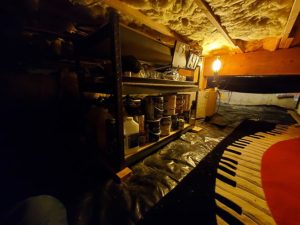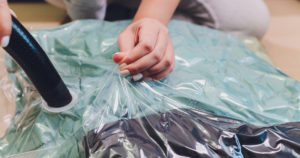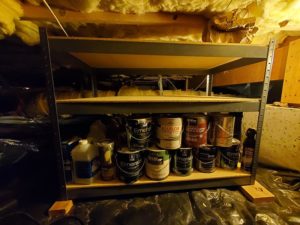One of the first things I noticed about the US after moving here from Australia was the prevalence of self storage units everywhere. And not just in rural areas, lining freeways, and city outskirts. They dot downtown business districts and residential suburbs. Roughly 10% of American households rent a self-storage unit, at an average cost of US$89/month. By comparison, Australian’s self storage industry is much smaller, though rapidly growing, partly in response to smaller home being built. So whether your home is a little cluttered or bursting at the seams,, here are some tips for utilising those nooks and crannies before you fork out for a storage unit.
Table of Contents
Set Your Criteria for Long Term Storage
I’ve faced backlash from housemates, my partner, and even guests for keeping certain items. Even if long-term storage places mean things are out of sight and out of mind, your co-habitants may still push back. Sharing these rules with my partner helped understanding and acceptance to form. Here is what we established:
Do you really need to keep it?
If it’s a box, will keeping it really help you transport the item when you move house, or will a moving box with padding suffice? If it’s a box you’re keeping to resell the item and maximize the sale price, consider flattening it and ditching the packaging material.
For books that are not on display, consider whether it can be borrowed from the library, or an ebook version sourced, either for purchase, borrow from a friend’s library, your local library, or just the page you needed searched on Google Books. If you’re planning on moving abroad, it most books are cheaper to re-purchase books than transport them.
Having said all that, there are things you absolutely should keep. My spouse could not get their head around needing to keep leftover paint, spare parts for things, and spare components of our kitchen cabinetry after our renovation. You can’t buy your way out of a problem if the part is discontinued, so do hold on to spares.
Audit and Dispose Of
Those cans of paint? Go through them and see which cans are for colors you no longer use in your house, or plan to change anyway.
Boxes for items you won’t need the box for again, because they can be transported in a generic box with bubblewrap, or you won’t need the box for to sell – recycle those. Keep in mind that everything you do get rid of demonstrates to others that you are indeed keeping what you need to, and are perhaps making a compromise.
Disposing of items can be hard, but consider lessening turning the pain of losing something into the warm and fuzzy feeling helping out your community members by giving away items in your local Buy Nothing group. Why, they’ll even pick it up too, for ultimate convenience.
How often do you need it?
In my home. anything accessed less that once per year can be placed in our crawl space under the house.
Whether you’re putting something in a self storage unit, in your attic or under your house, remember that it is going to be an inconvenience to retrieve the item(s). In my house, the rule I negotiated with my partner was that it could go into the crawl space beneath our home if it is needed less than once per year. Hence any leftover building materials like spare flooring and panels, paint, seasonal decorations (including our massive xmas tree), appliance components, and empty boxes make up almost the entirety of our crawl space storage.
Keep it Organised, Painless, and Even Nice
Spend the time now to maximize the amount of storage space you have, and make accessing it as painless and a quick process as possible. Noone is asking you to put up decorations, but the less painful it is to put or retrieve something somewhere, the more likely it will be use by you and others. Also remember, it might not be you looking for items. It might be a tradesperson, someone you live with, or a friend who is looking for something, or making multiple trips there.
- Make it comfortable
- Put spare rugs, carpet, old yoga mats, foam pads or even cardboard down, so it’s lesspainful on your knees when crawling on your knees
- Put pool noodles or other foam padding around places to bang your head
- Install hazard tape to highlight banging spots
- Install lighting
- Make it less scary and very easy to find items. Make it bright, with multiple sources to reduce creepy shadows.
- Make it downright pleasant. Go beyond function and make it nice. Use multiple sources of indirect light instead of harsh direct light. Make it BRIGHT.
- Make accessing the light switch easy. I use a smart plug and use a voice command with my Amazon Echo: “Alexa, basement lights on”
- Make finding items intuitive and obvious
- Group items by category
- Label, label, label. Use a big sheet of paper taped to boxes, and a thick pen so you can easily read contents from afar. List smaller items as bullet points.
- Make it less dusty.
- I vacuumed the concrete supports in the crawl space of my 25 year old home, vastly improving the experience of being down there, reducing the formation of dust on items placed down there, and reducing how dusty you are when you emerge.

Places to store items
Under The Bed
Bed frames with under-bed drawers are more expensive, and while a quick search will yield all manner of plastic boxes shaped to fit under your bed, keep in mind that clothing should be sealed to protect them from dust mites and clothing moths. Cardboard boxes will not do the trick, as I once found out when I had a cricket infestation in mine! If not a plastic box, use a a vacuum sealer bag.
As mentioned elsewhere in this article, don’t put frequently needed items under your bed. Professional Organiser, Vicky Silverthorn (younneedavicky.com) says told Good Housekeeping “My advice would be to only store items under the bed if it is a simple category and is simply organized, such as your seasonal clothing or items you only wear on your holidays.”
Under stairs
Under your stairs is a tricky place because of the narrow access and descending ceiling. Large items are best suited for under stairs, as are unusually shaped ones, like vacuum cleaners, bikes and brooms. Consider also installing hooks on the side and hanging brooms, mops, and rarely used coats.
Attic
Ceiling spaces get much hotter than your home or the outside temperature. An attic storage idea that
came out was that I put a wireless smart thermometer in my attic last summer here in Seattle and was surprised to see it get well above 50°F / 122°F. Imagine what happens in Australian heat. One thing is for sure, mine is too hot to enter in the summer after about 10am, which is why I don’t use mine at all.
If you do use yours, note that cardboard boxes become bone dry and a fire hazard, certain other packaging materials may melt, and/or age at an accelerated rate. Another risk for fire is lightning strikes, which is another reason cardboard boxes should not reside up in the attic. Store items in plastic, which has a higher flash/ignition point than cardboard, won’t feed silverfish and other insects, and is resistant to smoke and water damage.
Over 10,000 attic storage fires a year are reported to US Fire Departments according to the US Fire Administration.
Heat damage to items is a real risk. Never store fur or leather products in an attic; as the heat will damage leather, and fur will attract vermin. Do store other clothing items in sealed bags, like vacuum sealers. If you’re storing your holiday decorations in the attic, don’t store candles up there, lest you end up with a House of Wax scenario. Paintings and other artwork may fade.
Consider the type of insulation in your roof. Loose insulation can damage your lungs, and you may need to wear a face mask while up there.

Crawl Space
Depending on the place you live, and the style of house you have, you may or may not have a crawl space under your home. Popular in American wooden houses and rare in Australian brick ones, crawl spaces provide a cooler location in which to store items (perfect for paint!), though at a risk of flooding.
Garage Ceiling Storage
Garage ceiling storage has so many options you’ve probably never even heard of. From ceiling mounted shelves far from walls, to nets, spring-to-action claws, slings, pulley systems driving ceiling storage lifts, and more. Check out this list of products from FamilyHandyman for some great ideas.
Maximizing your storage space
Shelving – custom height
Making or commissioning custom-built shelving for your cramped space would time consuming and expensive, however customized off the shelf units are not! I’m a massive fan of wire shelving units, and while most stores sell them in fixed heights, usually about 6 feet / 180cm tall (though they often unscrew in the middle, which is what I did), you can buy poles in much smaller increments. This Amazon seller sells one inch wire rack poles in 14”, 34”, 54”, 64”, 74”, 86” and 96” sizes! Worst case scenario, buy a cheap wire rack locally or source an existing one, and take to it with a hacksaw!
Shelving – extra shelves
Another great thing about wire racks is how easy it is to buy more shelves, beyond the 4 or 6 yours came with. This allows you to have several smaller shelves at eye height to store smaller or flatter things. Many stores only sell all-in-one kits for modular shelves, and no extra shelves, so consider this when researching where to buy your shelves.
Corners: pentagon shelving
No more losing accessibility to a corner due to a pole blocking the access. Consider buying a pentagon shelving unit. They look amazing too. Amazon have a variety of height sizes, theshelvingstore.com have them for much cheaper. I suggest hunting around. Ultimately, the poles can be bought separately, or foregone completely if attaching to other rectangular units of the right size.

Box small items together and label
Everyone has a junk drawer, and junk boxes in storage also accumulate easily. Again, remember, it might not be you needing to find something. So again, group by category, and tape a big plain sheet of paper to the front, and label with a thick pen in big writing what the contents are, perhaps in bullet points.
Store Boxes Within Boxes, and Clearly Label
I keep the boxes for my electronics because I sometimes sell them, and this increases the sale price. I mentioned above getting rid of the packaging and folding them flat. Another tip is to put empty boxes within boxes of larger items, russian stacking doll style, and clearly labelling the outermost box.
Shelving Accessories: Hooks, baskets, hangers, rails, and more
Many shelving solutions, from wall-mounted shelfracks, to freestanding wire racks offer various styles of hooks, sliding drawers, baskets, dividers, label mounts and more. Yet another reason why I love standardized 1” wire racks. Check out these accessories at shelving.com, or if you live in the US, walk into your local Container Store. They’ll…ahem, rack your world.
Concrete or Masonry Foundation of Wooden Houses
If you have a wooden house, your walls likely sit atop a small concrete or block wall, on which treated lumber sits (known as the mud sill), upon which the walls sit. This wider flat surface can store items. However mine was very wide, it was not flat because there were mounds of caked sand, dust, and and other debris on it. I spent the time to scrape and vacuum all this to get a flat surface upon which I can now store items in a stable position, elevated from any flooding that may occur.

Final Important Considerations
Shelves on non-flat and non-stable surfaces
Wire racks can be constructed with each pole at different heights, however they won’t be able to be moved, and if placed on non-solid ground, like sand or gravel, the ground might shift further. Consider using scrap planks of wood to get the height right, and keep it that way.

Can the shelf or box carry the weight?
If you’re storing heavy items, like flooring, liquids, paint, wood, etc, check to see the weight capacity of any suspended solution, or shelving. Commercial grade shelving and wire racks, and higher rated drywall anchors are available for this reason. And remember, if your house uses drywall, drill into studs if you can.
Don’t rely on cardboard to retain its strength. Water weakens cardboard, and nothing reduces the strength of tape adhesive better than time, heat, or both.
What if my crawlspace or basement floods?
As someone whose sump pump failed during the last winter, resulting in the purchase of multiple flood sensors, I guarantee that you don’t want to store anything you’ll be that bummed about losing, whether to flooding, vermin damage, or something else.
Consider the lower points of the space and consider not storing anything there, propping up shelving there with wood, and storing water resistant items there. E.g. Paint cans, other bottled/canned liquids, waterproof materials like plastic flooring and space pipes, etc.
This is a time and money investment
Cleaning the space, choosing; collecting; transporting; constructing and installing shelving; hooks; drawers etc, moving your items into the space; organizing; sorting and labelling them…this all takes money, time, energy, and perhaps some convincing of your co-habitants. Going into a project that maximizes your storage space, do so in an informed mannger, and be prepared to pay for the pros, and consider spreading out the project. A decluttered home, and not having to pay for harder to get to self-storage is your reward.



Terrific suggestions David! Having moved 11 times in 27 years I have decluttered many times, however I have occupied my present home for over 4 years and am starting to accumulate again!
Best wishes, wendy (Western Australia)